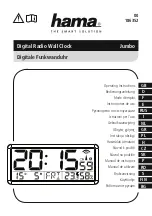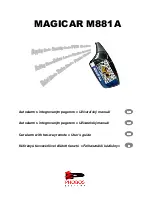
La Crosse Technology, Ltd. www.lacrossetechnology.com/support
Page 9
Operating on battery power only:
Press and release the
SNOOZE/LIGHT button on top of the Atomic Projection Alarm to
show the
projection for 5 seconds.
Note:
Projection will not display constantly when operating on battery power.
Daylight Saving Time
Dependent on your location, position of the clock in your home, and atmospheric interference, it may
take up to 5 nights for the change from Daylight Savings Time to Standard Time and vice-versa to
occur.
Check for a
Tower Icon showing on your Clock. The tower icon indicates you have received
the WWVB signal from Ft Collins CO in the past 24-hours.
Check that the clock is in the correct
Check whether the DST indicator is ON or OFF. If the indicator is OFF the clock will not change.
Check for fresh
. Without proper batteries, the antenna will have a harder time picking up
the signal.
Position the Atomic Projection Alarm in a window (
with the front or back
) facing Ft. Collins, Colorado
and leave for up to five nights. If you do not have a window facing this direction, locate the Clock near
an outside wall and point the unit in this general direction.
No WWVB Tower Icon
The Atomic Projection Alarm has not received a WWVB time signal in the past 24-hours.
Position
the Atomic Projection Alarm for better reception.
Hold the
-/TIME
button to send the Atomic Projection Alarm on a signal search at night.
Allow up to 5 nights to receive the time signal.
Moon Phase
The eight phases of the moon shown below are determined by the year, month, and date set on the
Atomic Projection Alarm.
Note
: With the moon shown against a light colored background, the phases will show opposite to a paper
calendar.
The segments that are highlighted portray the part of the moon that is lit
. For instance, the
moon will be blank during a new moon and dark during a full moon.
New Moon
occurs when the moon is between the earth and sun so the illuminated portion of the
moon is on the backside facing the sun and we cannot see it. After a new moon, the illuminated
portion will increase or wax until the full moon occurs.
Full Moon
occurs when the earth, moon, and sun are in approximate alignment, with the moon and
the sun on opposite sides of the earth. The illuminated portion of the moon faces the earth, giving us
complete visibility of one side of the entire moon. After a full moon, the illuminated portion will
decrease or wane until the new moon occurs.
First Quarter
and
Last Quarter
moons occur when the moon is at a 90-degree angle to the earth
and sun. Therefore, we see half of the moon illuminated and half is in shadow.
Waxing
means growing or expanding illumination and happens after a new moon.
Waning
means decreasing illumination and occurs after a full moon.
Crescent
refers to the moon being less than half-illuminated. Crescents can be waning or waxing.
Gibbous
describes a moon phase when more than half is illuminated. Gibbous can be waxing or
waning.
Projection alarm is dim
Explanation:
Most projection alarms have a gray background. Place the projection alarm at eye level, to
determine if it is dim. Projection alarms that sit in the sunlight can develop a cloudy film over time.
This is generally a power related issue.
may be overpowered or underpowered. Remove batteries from projection alarm.
Press any button 20 times. Leave the projection alarm unpowered for 1-2 hours.
Install fresh alkaline batteries with correct polarity.




























